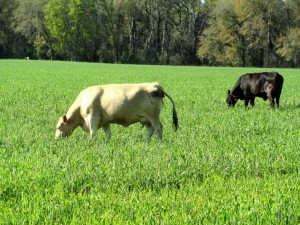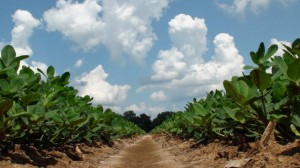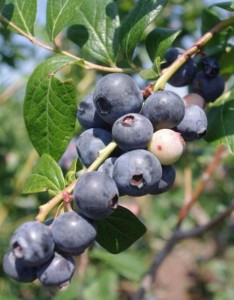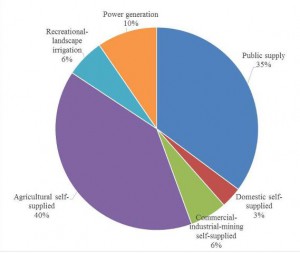
EDIS is the University of Florida’s Official website with fact sheets available to download on a wide variety of topics for free.
The University of Florida IFAS Extension offers a database of fact sheets available for free download on the Internet called EDIS (Electronic Data Information Source) that has many publications of interest to farmers and ranchers in Northwest Florida. Each fact sheet has a PDF or printer friendly link in the top left corner. The following are just a few of the new fact sheets that were recently added to the collection pertaining to commercial agriculture production. http://edis.ifas.ufl.edu
 Cattle
Cattle
The Interaction of Nutrition and Health in Beef Cows
In cattle, all physiological processes in the body, including the immune system, are influenced by the cattle’s nutritional status. Therefore, the past and present nutritional status serves as an immune function modulator in cattle that can influence the performance and reproduction of beef cattle. This 6-page fact sheet was written by Matt Hersom, and published by the UF Department of Animal Sciences, June 2014.
http://edis.ifas.ufl.edu/an292
 Row Crops
Row Crops
2013 Evaluation of In-Furrow and Foliar Fungicides for Disease Control in Peanut in Jay, Florida
This 10-page fact sheet summarizes the 2013 in-furrow and foliar fungicide programs for control of early and late leaf spot and white mold (southern stem rot) of peanut in Jay, Florida. It shows the effectiveness of 13 fungicide programs for disease control, as compared to no treatment. These data represent only one year and one location, and readers are cautioned that test results should be considered over several locations and years before final conclusions are valid. Written by Darcy E. P. Telenko, John Atkins, and Nick Dufault, and published by the UF Department of Plant Pathology, January 2014.
http://edis.ifas.ufl.edu/pp310
2013 Evaluation of Non-Irrigated Early-Maturing Cotton Varieties in Jay, Florida
This report includes a summary of the 2013 early-season cotton Official Variety Trial in Jay, Florida. It shows the performance of 11 cotton varieties. These data represent only one year and one location, and readers are cautioned that test results should be considered over several locations and years before final conclusions are valid. This 5-page fact sheet was written by Darcy Telenko and Michael Donahoe , and published by the UF Department of Agronomy, January 2014.
http://edis.ifas.ufl.edu/ag378
Vegetables
2013 Sweet Corn Variety Performance Trial, Jay, Florida
This 5-page fact sheet summarizes the 2013 sweet corn variety trial at the UF West Florida Research and Education Center Jay Research farm in Jay, Florida. It shows the performance of fifteen commercial and experimental Sh2 (supersweet) sweet corn varieties. These data only represent one year and one location; test results should be considered over several years and locations before final conclusions are valid. Written by Darcy Telenko, Libby Johnson, and William Wendt, and published by the UF Department of Horticultural Sciences, November 2014.
http://edis.ifas.ufl.edu/hs1236
How to Determine Run Time and Irrigation Cycles for Drip Irrigation: Tomato and Pepper Examples
Even though drip irrigation is more efficient than the other irrigation methods, proper system management is crucial if that increased efficiency is going to result in water savings and a viable crop. One important aspect of drip irrigation management for crop success is irrigation scheduling, which includes determining both how much and when to irrigate. The grower can use several different methods to help develop a suitable irrigation schedule. Proper scheduling needs to be implemented to take full advantage of the increased drip irrigation efficiency. Two examples are presented in this 5-page fact sheet for tomatoes and peppers, which are two important vegetable crops in Florida, to demonstrate the use of reference evapotranspiration and crop coefficients in developing a drip irrigation schedule. Written by Sanjay Shukla, James M. Knowles, and Niroj K. Shrestha, and published by the UF Department of Agricultural and Biological Engineering, April 2014.
http://edis.ifas.ufl.edu/ae500
Heirloom Hot Pepper Varieties for Florida
Here is a guide of the popular pepper varieties used in Florida. The popularity was assessed from a survey among seed suppliers, which include Baker Creek Heirloom Seeds, Burpee, High Mowing Seeds, Southern Exposure Seed Exchange, Tomato Grower Supply Company, Seeds of Change, Territorial Seed Company, and My Patriot Supply. When organic seeds were available, the USDA logo was inserted. The relative Scoville rating, which measures a pepper’s pungency, was also included when it was available. This 15-page fact sheet was written by Monica Ozores-Hampton, and published by the UF Department of Horticultural Sciences, November 2014.
http://edis.ifas.ufl.edu/hs1244
 Fruit
Fruit
Southern Highbush Blueberry Cultivars from the University of Florida
Many improved southern highbush cultivars have been developed by the University of Florida breeding program since the initial releases of ‘Sharpblue’, ‘Flordablue’, and ‘Avonblue’ in the mid-1970s. Today there are more blueberry cultivar choices available for Florida growers than ever before, but in every case, cultivar selection involves weighing the advantages and disadvantages of a cultivar relative to the grower’s needs. Unfortunately, there are no perfect cultivars suited for every location and management system. This 10-page fact sheet categorizes southern highbush cultivars into four groups: major cultivars, secondary cultivars, new options, and historical cultivars. Proper cultivar selection is critical to a successful blueberry enterprise, and growers should seek information from multiple sources, including their local county Extension office. Written by J.G. Williamson, J.W. Olmstead, G.K. England, and P.M. Lyrene, and published by the UF Department of Horticultural Sciences, April 2014.
http://edis.ifas.ufl.edu/hs1245
 Pests
Pests
Mole Cricket IPM Guide for Florida
Mole crickets can become serious pests of turfgrasses, pastures, and vegetable seedlings. The first step in determining if you have a mole cricket problem at a site is to compare the existing damage to pictures of known mole cricket damage. If the damage is likely caused by mole crickets, specimens should be obtained and the pest identified. You then should determine if the number of mole crickets is great enough to cause an unacceptable level of damage and decide what control measures should be used. Eventually, a long-term, sustainable integrated pest management (IPM) program should be established. This 20-page guide will help you identify mole cricket infestations and manage them effectively and economically while minimizing environmental impacts. Written by C. R. Kerr, N. C. Leppla, E. A. Buss, and J. H. Frank, and published by the UF Department of Entomology and Nematology, May 2014.
http://edis.ifas.ufl.edu/in1021
 Natural Resources
Natural Resources
Water Withdrawals and Their Use in Florida in 2010
This publication is based on Florida water use information collected by the United States Geological Service. It expands on EDIS document FE797 that examined Florida water withdrawals data for 2005. In addition, in EDIS document FE757 (Florida’s Water Resources), the authors describe Florida’s abundant water resources—the state receives about 54 inches of rainfall per annum, compared to 30 inches nationwide, and it overlies prolific aquifers. Whether water is scarce or abundant, however, depends not only upon available supplies, but also upon patterns of water use. To gather this information, the United States Geological Survey employs several water-use categories to develop estimates of water withdrawals and water use. This 5-page fact sheet was written by Tatiana Borisova and Jenna Rogers, and published by the UF Department of Food and Resource Economics, May 2014.
http://edis.ifas.ufl.edu/fe943
- August 2025 Weather Summary and Fall Outlook - September 5, 2025
- Friday Feature:How High Can Feeder Calf Prices Go? - September 5, 2025
- Friday Feature:New Cotton Varieties with Root-Knot & Reniform Nematode Resistance - August 29, 2025

